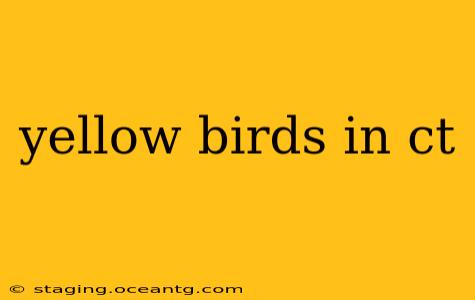Connecticut, with its diverse habitats ranging from coastal marshes to forested hills, plays host to a variety of bird species, several of which boast vibrant yellow plumage. Identifying these feathered friends can be a delightful pastime for birdwatchers of all levels. This guide explores the common yellow birds found in Connecticut, offering helpful identification tips and insights into their behavior and habitats.
What are some common yellow birds found in Connecticut?
Several species of yellow birds grace the Connecticut landscape. Some of the most frequently sighted include the American Goldfinch, the Yellow Warbler, the Northern Flicker (showing yellow markings), and the Baltimore Oriole. The specific species you're likely to encounter will depend on the season and the location within the state.
American Goldfinch: A Tiny Burst of Sunshine
The American Goldfinch (Spinus tristis) is a small, vibrant bird easily recognizable by its bright yellow body, contrasting black wings, and a distinctive, notched tail. Males exhibit a more intense yellow coloration during the breeding season. They're often found in fields, meadows, and along roadsides, feeding on thistle and sunflower seeds.
Yellow Warbler: A Songbird of the Woodlands
The Yellow Warbler (Setophaga petechia) is a lively, active warbler with a bright yellow body, chestnut streaks on its breast (in some subspecies), and a noticeable white eye ring. These birds prefer woodland edges, thickets, and even gardens, where they forage for insects among the foliage. Their songs are sweet and distinctive, adding to their charm.
Northern Flicker: A Touch of Yellow in the Woodpecker Family
While not entirely yellow, the Northern Flicker (Colaptes auratus) displays striking yellow markings on its underparts and rump. This medium-sized woodpecker is identifiable by its speckled back, black crescent on its breast, and a prominent black "mustache" stripe. They're often spotted foraging on the ground or drumming on trees.
Baltimore Oriole: A Flash of Orange and Black
The Baltimore Oriole (Icterus galbula) is a showstopper with its bright orange and black plumage. While not entirely yellow, the orange coloration makes it a frequent inclusion in discussions about "yellow" birds due to its similarity in hue. These birds are found in deciduous forests and wooded areas, often building hanging nests.
Where can I find yellow birds in Connecticut?
The best places to spot yellow birds in Connecticut depend largely on the species. However, some general locations offer good opportunities for birdwatching:
- State Parks and Wildlife Areas: These protected areas often provide diverse habitats that attract a wide range of bird species, including those with yellow plumage.
- Nature Centers and Sanctuaries: These locations often have established trails and bird feeders, making birdwatching more convenient.
- Gardens and Backyards: Providing bird-friendly landscaping, such as native plants and feeders, can attract yellow birds to your own backyard.
What time of year is best for birdwatching in CT?
Spring and fall migration periods generally offer the best opportunities to spot a wider variety of bird species, including those that may only pass through Connecticut during their travels. However, you can see resident yellow birds like the American Goldfinch year-round.
What is the best way to attract yellow birds to my yard?
Creating a bird-friendly habitat is key to attracting yellow birds. Consider planting native wildflowers and shrubs that provide food and shelter. Offering a variety of bird feeders with sunflower seeds, thistle seeds, and suet can also be effective. Providing a clean water source is also important.
What is the conservation status of yellow birds in Connecticut?
Most of the common yellow birds in Connecticut are not currently considered threatened or endangered, but it's important to protect their habitats and ensure sustainable practices to maintain their populations.
By understanding the different species, their habitats, and their preferences, you can significantly increase your chances of spotting these beautiful yellow birds in Connecticut. Happy birdwatching!
